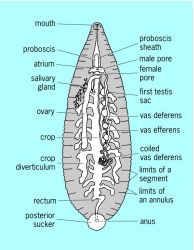Hirudinea
Also found in: Dictionary, Thesaurus, Medical, Wikipedia.
Hirudinea
A class of the annelid worms commonly known as leeches. These organisms are parasitic or predatory and have terminal suckers for attachment and locomotion. Most inhabit inland waters, but some are marine and a few live on land in damp places. The majority feed by sucking the blood of other animals, including humans.
Leeches differ from other annelids in having the number of segments in the body fixed at 34, chaetae or bristles lacking, and the coelomic space between the gut and the body wall filled with packing tissue (see illustration). In a typical leech the first six segments of the body are modified to form a head, bearing eyes, and a sucker, and the last seven segments are incorporated into a posterior sucker.
The mouth of a leech opens within the anterior sucker, and there are two main methods of piercing the skin of the host to obtain blood: an eversible proboscis or three jaws, each shaped like half a circular saw, placed just inside the mouth. The process of digestion is very slow, and a meal may last a leech for 9 months. The carnivorous forms have lost most or all of their gut diverticula and resemble earthworms in having a straight, tubular gut. Leeches are hermaphroditic, having a single pair of ovaries and several pairs of testes.
The importance of leeches as a means of making incisions for the letting of blood or the relief of inflammation is declining, and in developed countries the bloodsucking parasites of mammals are declining, because of lack of opportunity for contact with the hosts. In other countries they are still serious pests.
Hirudinea
(leeches), a class of annelid worms. Leeches are mostly black, yellowish brown, or greenish. Their flattened or, less frequently, cylindrical body consists of a prostomium and 33 body segments. The cutaneous coverings of the segments are divided into three to five (or more) annuli. There are two suckers: one anterior and one posterior. Leeches range in length from 0.2 to 15 cm. Most species have from one to five pairs of eyes. The anterior and posterior ganglia of the ventral nerve cord merge in the subpharyngeal and posterior nerve masses owing to the formation of suckers. The musculature is well developed. The secondary body cavity, or coelom, is reduced, and the spaces between organs are filled with mesenchyme. Most of the blood vessels are formed from vestiges of the coelom that have acquired muscular walls. Respiration is cutaneous. Some species have respiratory bladders or branchial gills.
The majority of leeches suck the blood and body juices of various vertebrates and invertebrates. Those that are not bloodsuckers are predators that swallow their prey whole. The salivary glands of bloodsucking species excrete hirudin, a substance that hinders clotting of the blood. Some leeches have a proboscis in the anterior part of the digestive tract. Others have toothed jaws to enable them to destroy the cutaneous coverings of their prey. The jaws of predatory leeches are for the most part reduced. Reproduction is sexual, and all leeches are hermaphroditic. The fertilized eggs are deposited in cocoons.
Most leeches live in fresh waters, where they are often numerous and play an important role in the breakdown of matter. The remaining species live in the sea or in damp soil. Some fishes eat leeches, as do desmans. Several leeches, such as the medicinal leech (Hirudo medicinalis), are used in the treatment of several diseases. Fish and bird leeches may cause mass destruction of their hosts. The horseleech (Haemopis), which is found in the USSR in Transcaucasia and Middle Asia, enters the throat of horses with drinking water. The leeches may lodge in the animal’s throat and cause suffocation.
There are two subclasses of leeches: old leeches and present-day leeches. The first subclass includes two species of the genus Acanthobdella, which have preserved a number of features of oligochaete worms—the ancestors of leeches. The present-day leeches comprise the order Rhyncobdellae, which includes the families Glossiphoniidae and Ichtyobdellidae, and the order Gnathobdellida, which includes the families of jawed leeches and pharyngeal leeches. Of the approximately 400 species of leeches (according to other data, 300), about 60 are found in the USSR.
REFERENCES
Rukovodstvo po zoologii, vol. 2. Moscow-Leningrad, 1940.Zhizn’ presnykh vod SSSR,[vol.] 2. Moscow-Leningrad, 1949.
Zhizn’ zhivotnykh, vol. 1. Moscow, 1968.
Lukin, E. I. Piiavky. Kiev, 1962. (Fauna Ukrainy, vol. 30.)
Mann, K. H. Leeches (Hirudinea). Oxford, 1962.
E. I. LUKIN
